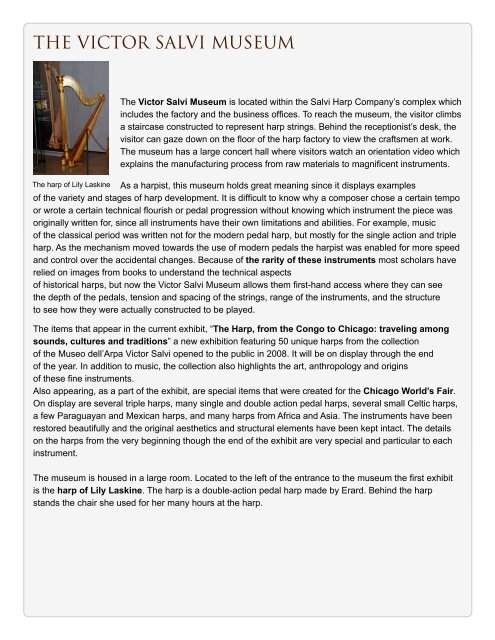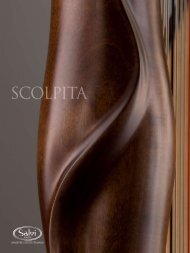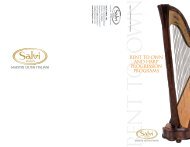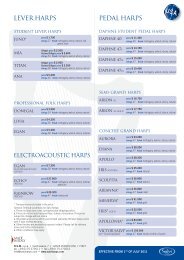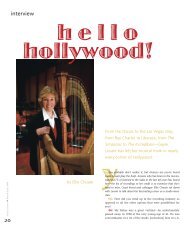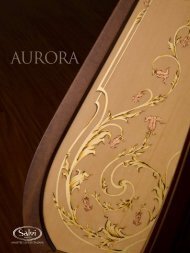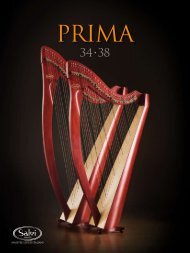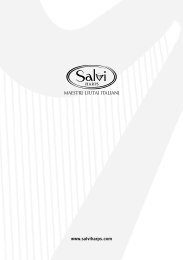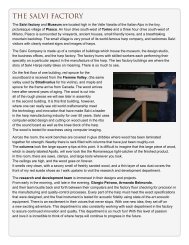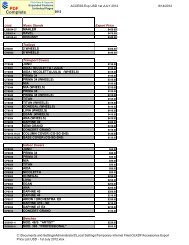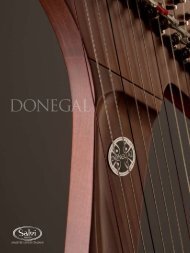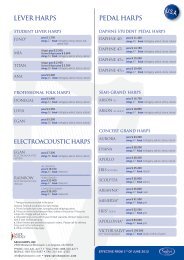THE VICTOR SALVI MUSEUM - Salvi Harps, Inc.
THE VICTOR SALVI MUSEUM - Salvi Harps, Inc.
THE VICTOR SALVI MUSEUM - Salvi Harps, Inc.
Create successful ePaper yourself
Turn your PDF publications into a flip-book with our unique Google optimized e-Paper software.
The Victor <strong>Salvi</strong> Museum<br />
The Victor <strong>Salvi</strong> Museum is located within the <strong>Salvi</strong> Harp Company’s complex which<br />
includes the factory and the business offices. To reach the museum, the visitor climbs<br />
a staircase constructed to represent harp strings. Behind the receptionist’s desk, the<br />
visitor can gaze down on the floor of the harp factory to view the craftsmen at work.<br />
The museum has a large concert hall where visitors watch an orientation video which<br />
explains the manufacturing process from raw materials to magnificent instruments.<br />
As a harpist, this museum holds great meaning since it displays examples<br />
of the variety and stages of harp development. It is difficult to know why a composer chose a certain tempo<br />
or wrote a certain technical flourish or pedal progression without knowing which instrument the piece was<br />
originally written for, since all instruments have their own limitations and abilities. For example, music<br />
of the classical period was written not for the modern pedal harp, but mostly for the single action and triple<br />
harp. As the mechanism moved towards the use of modern pedals the harpist was enabled for more speed<br />
and control over the accidental changes. Because of the rarity of these instruments most scholars have<br />
relied on images from books to understand the technical aspects<br />
of historical harps, but now the Victor <strong>Salvi</strong> Museum allows them first-hand access where they can see<br />
the depth of the pedals, tension and spacing of the strings, range of the instruments, and the structure<br />
to see how they were actually constructed to be played.<br />
The items that appear in the current exhibit, “The Harp, from the Congo to Chicago: traveling among<br />
sounds, cultures and traditions” a new exhibition featuring 50 unique harps from the collection<br />
of the Museo dell’Arpa Victor <strong>Salvi</strong> opened to the public in 2008. It will be on display through the end<br />
of the year. In addition to music, the collection also highlights the art, anthropology and origins<br />
of these fine instruments.<br />
Also appearing, as a part of the exhibit, are special items that were created for the Chicago World’s Fair.<br />
On display are several triple harps, many single and double action pedal harps, several small Celtic harps,<br />
a few Paraguayan and Mexican harps, and many harps from Africa and Asia. The instruments have been<br />
restored beautifully and the original aesthetics and structural elements have been kept intact. The details<br />
on the harps from the very beginning though the end of the exhibit are very special and particular to each<br />
instrument.<br />
The museum is housed in a large room. Located to the left of the entrance to the museum the first exhibit<br />
is the harp of Lily Laskine. The harp is a double-action pedal harp made by Erard. Behind the harp<br />
stands the chair she used for her many hours at the harp.
Another section of the museum houses the African harp collection. All of<br />
these instruments look quite individual and unique. Each harp has its own<br />
character. The harps were made from indigenous materials that would have<br />
been quite easy to find in nature: gourds, wood, shells, skin, bone, and roots.<br />
They range in size from as few as four strings to twenty or so strings. It is<br />
evident that many of these harps were used as cultural symbols, artwork,<br />
and spiritual pieces and were not just made to create music.<br />
The forms of these harps are generally some sort of C–shape, to most likely be<br />
played in the lap. Others are for more aesthetic and artistic ends; they would<br />
probably be played on some sort of table or stand<br />
as they are formed in a very decorative shape. In all cases though, you can see<br />
the culture from where the harp originated in the structure and decoration<br />
of the harps.<br />
The exhibit of single action pedal harps is<br />
amazing. From Parigi to Erard, you can really<br />
understand the harp that Naderman wrote his<br />
etudes on when you actually see his harps. One<br />
of his harps is a single-action, Parigi harp from<br />
1785 with shallow, flat pedals, and a staved body.<br />
The artistic details are very intricate, in terms of<br />
the carving, gilding and hand painting. The harp<br />
is elaborately decorated with the bust of a woman<br />
and cherubs, which are beautifully gilded in gold.<br />
Naderman’s music, for the most part, is written<br />
at fast tempi with large reaches at a forte. All of<br />
the dynamics, pedal changes, reaches, and tempi make much more sense after actually seeing the harps.<br />
Aside from the harps’ technical capabilities, these harps are also gorgeous pieces of artwork: each very<br />
unique and colorful.<br />
A visit to the museum, surrounded by the Italian Alps and the magnificent factory with its dedicated artisans<br />
leaves the visitor with a feeling of communion with the gods!<br />
For more information or a DVD of the museum contact <strong>Salvi</strong> <strong>Harps</strong>, <strong>Inc</strong>.<br />
A catalog of the museum is available, “Three Centuries of <strong>Harps</strong>,” from most harp music retailers<br />
for $50. The book was written by Roslyn Rensch and has detailed photos throughout. It is excellent<br />
for both a resource and a coffee table book.


